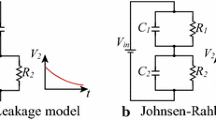Abstract
This paper presents the electric field analysis as well as the experimental verifications of a silicone rubber insulator by considering DC and AC voltage conditions. As a first step, a 3D electric field simulation of the insulator was performed by using a commercially available software based on finite element method. DC voltage and 50 Hz power–frequency voltage simulations were conducted for the given insulator. Low frequency field distribution along the insulator has been investigated to find threshold frequency values for resistive and capacitive field regions. The effect of the conductivity of air surrounding the insulating system on the electric field was evaluated. For each condition, electric potential and field distribution along the creepage path of the insulator was obtained. In addition to the simulation studies, voltage measurements under AC and DC conditions utilizing a different approach for the silicone rubber insulators were conducted on the insulator by using a non-contact type electrostatic voltmeter to validate the simulation results.
















Similar content being viewed by others
References
Arshad Nekahi A, McMeekin SG, Farzaneh M (2018) Measurement of surface resistance of silicone rubber sheets under polluted and dry band conditions. Electr Eng 100:1729–1738. https://doi.org/10.1007/s00202-017-0652-x
Anbarasan R, Usa S (2015) Electric field computation of polymeric insulator using reduced dimension modeling. IEEE Trans Dielectr Electr Insul 22(2):739–746. https://doi.org/10.1109/TDEI.2015.7076770
Chandrasekar S, Sarathi R, Danikas MG (2007) Analysis of surface degradation of silicone rubber insulation due to tracking under different voltage profiles. Electr Eng 89:489–501. https://doi.org/10.1007/s00202-006-0029-z
Zhao T, Comber MG (2000) Calculation of electric field and potential distribution along non-ceramic insulators considering the effects of conductors and transmission towers. IEEE Trans Power Deliv 15(1):313–318. https://doi.org/10.1109/61.847268
Bao W et al (2017) Effects of AC and DC corona on the surface properties of silicone rubber: characterization by contact angle measurement and XPS high resolution scan. IEEE Trans Dielectr Electr Insul 24(5):2911–2919. https://doi.org/10.1109/TDEI.2017.006774
Phillips AJ et al (2008) Electric fields on AC composite transmission line insulators. IEEE Trans Power Deliv 23(2):823–830. https://doi.org/10.1109/TPWRD.2007.911127
Benziada MA, Boubakeur A, Mekhaldi A (2018) Numerical simulation of the electric field distribution in point-barrier-plane air gaps. IEEE Trans Dielectr Electr Insul 25(6):2093–2102. https://doi.org/10.1109/TDEI.2018.007160
Bahrman MP (2006) Overview of HVDC transmission. In: IEEE power systems conference and exposition (PSCE), Chicago, IL, USA, pp 18–23. https://doi.org/10.1109/PSCE.2006.296221
Que W, Sebo SA, Hill RJ (2007) Practical cases of electric field distribution along dry and clean non-ceramic insulators of high-voltages power lines. IEEE Trans Power Deliv 22(2):1070–1078. https://doi.org/10.1109/TPWRD.2007.893190
He J, Gorur RS (2014) Charge simulation based electric field analysis of composite insulators for HVDC lines. IEEE Trans Dielectr Electr Insul 21(6):2541–2548. https://doi.org/10.1109/TDEI.2014.004541
Löfås H, Lavesson N (2017) Ion drift simulations of the DC electric field in air around a high voltage bushing. In: 2017 IEEE conference on electrical insulation and dielectric phenomenon (CEIDP), Fort Worth, TX, USA, pp 30–33. https://doi.org/10.1109/CEIDP.2017.8257457
Saltzer M et al (2011) Observation of space charge dynamics in air under DC electric fields. 2011 In: Annual report conference on electrical insulation and dielectric phenomena, Cancun, Mexico, pp 141–144. https://doi.org/10.1109/ceidp.2011.6232616
Whiteley J (2017) Finite element methods a practical guide. Springer, Oxford
Hayt HW, Buck JA (2012) Engineering electromagnetics. McGraw-Hill, New York
Quin S et al (2016) The influence of the insulator volume conductivity on charge accumulation in HVDC-GIL. In: 2016 IEEE electrical insulation conference (EIC), Montreal, QC, Canada, pp 325–328. https://doi.org/10.1109/eic.2016.7548593
Okubo H (2018) HVDC electrical insulation performance in oil/pressboard composite insulation system based on kerr electro-optic field measurement and electric field analysis. IEEE Trans Dielectr Electr Insul 25(5):1785–1797. https://doi.org/10.1109/TDEI.2018.007187
Jaiswal V, Farzaneh M, Lowther DA (2005) Impulse flashover performance of semiconducting glazed station insulator under icing conditions based on field calculations by finite-element method. IEE Proc Gener Transm Distrib 152(6):864–870. https://doi.org/10.1049/ip-gtd:20045231
Yu X et al (2018) Influence of non-uniform hydrophobicity distribution on pollution flashover characteristics of composite insulators. IET Sci Meas Technol 12(8):1009–1014. https://doi.org/10.1049/iet-smt.2018.5266
Othman NA, Piah MAM, Adzis Z (2016) Space charge distribution and leakage current pulses for contaminated glass insulator strings in power transmission lines. IET Gener Transm Distrib 11(4):876–882. https://doi.org/10.1049/iet-gtd.2016.0793
Train D, Dube R (1983) Measurements of voltage distribution on suspension insulators for HVDC transmission lines. IEEE Trans Power Appl Syst 102(8):2461–2475. https://doi.org/10.1109/TPAS.1983.317746
Källstrand B et al (2017) Measurement of high voltage DC fields in air. IEEE Electr Insul Mag 33(2):24–34. https://doi.org/10.1109/MEI.2017.7866676
Othman NA et al (2014) Characterization of charge distribution on the high voltage glass insulator string. J Electrostat 72:315–321. https://doi.org/10.1016/j.elstat.2014.05.003
Acknowledgements
The authors would like to thank to Istanbul Technical University, Fuat Kulunk High Voltage Laboratory staff.
Author information
Authors and Affiliations
Corresponding author
Additional information
Publisher's Note
Springer Nature remains neutral with regard to jurisdictional claims in published maps and institutional affiliations.
Rights and permissions
About this article
Cite this article
Uckol, H.I., Karaca, B. & Ilhan, S. DC and AC electric field analysis and experimental verification of a silicone rubber insulator. Electr Eng 102, 503–514 (2020). https://doi.org/10.1007/s00202-020-00954-3
Received:
Accepted:
Published:
Issue Date:
DOI: https://doi.org/10.1007/s00202-020-00954-3




